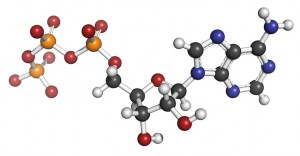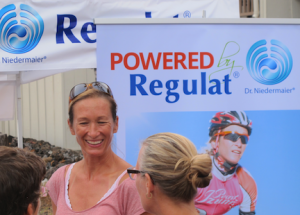 Nutrition is an important component of an athlete’s overall performance, before, during and after competition. By using nutrients the body absorbs through food consumption, we are able to obtain energy. Mitochondria are the ‘furnaces’, responsible for producing this energy. They are the powerhouses located within cells and convert glucose (a sugar molecule derived from carbohydrates) to adenosine triphosphate (ATP). Often called the “molecular unit of currency” of intracellular energy transfer*, ATP is a coenzyme that enables our cells to perform a spectrum of functions, and is the main source of energy that allows the body to generate movement.
Nutrition is an important component of an athlete’s overall performance, before, during and after competition. By using nutrients the body absorbs through food consumption, we are able to obtain energy. Mitochondria are the ‘furnaces’, responsible for producing this energy. They are the powerhouses located within cells and convert glucose (a sugar molecule derived from carbohydrates) to adenosine triphosphate (ATP). Often called the “molecular unit of currency” of intracellular energy transfer*, ATP is a coenzyme that enables our cells to perform a spectrum of functions, and is the main source of energy that allows the body to generate movement.
ATP and athletic performance, then, are closely related. ATP provides energy your body needs for muscle contractions, blood circulation and cardiac function, and generally fuels the body for whatever function it may be performing. The harder, longer, and more intense the workout, the more ATP that is used. When an athlete repeatedly dips into their ATP source day after day, week after week, there must be replenishment or else they begin to run that energy source dry. This can obviously cause a loss in athletic performance – the athlete would not be able to operate at prime capacity if the ‘engine’ doesn’t have fuel.
The human body produces ATP through the consumption of food eaten daily. However, there are many internal and external factors that may hinder the amount of nutrients we are able to absorb and assimilate. This may include foods treated with pesticides and other harmful substances, medications, metabolic stress, gut flora issues, and other factors that don’t provide optimal conditions for the body to produce ATP.
It is particularly important for athletes whose metabolic processes must perform at an optimal level day in and day out, that their diet include easily absorbed (natural) vitamins, minerals, trace nutrients, and high quality proteins. The ideal is to have a natural source of highly active nutrients in a form that is easily absorbed by the body and this is where cascade fermentation holds the key to success – natural foods are broken down into highly bio-available liquid nutrients and building blocks. Incorporating a supplement such as Regulat® helps increase ATP and athletic performance – in a study where participants used the product twice a day for three months, they showed an increase in ATP of more than 180% compared to baseline. The more quality building blocks are available, the more training will influence the formation of new mitochondria.
With sufficient ATP available, the body will encounter less anaerobic emergency situations even during high physical efforts. The math is simple: if the body’s own enzyme system in mitochondria is functioning optimally and the number of mitochondria is increasing at the same time, then the available oxygen is also being used at its optimum. This results in a boost in performance even without any additional training.**
For more information, please view the sources below.
*Knowles, J. R. (1980). “Enzyme-catalyzed phosphoryl transfer reactions”. Annu. Rev. Biochem.
**“Are you already on ATP, or are you still training?” TriTime Magazine.



